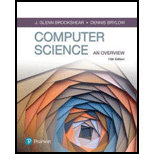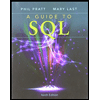
Computer Science: An Overview (13th Edition) (What's New in Computer Science)
13th Edition
ISBN: 9780134875460
Author: Glenn Brookshear, Dennis Brylow
Publisher: PEARSON
expand_more
expand_more
format_list_bulleted
Expert Solution & Answer
Chapter 9.3, Problem 1QE
Explanation of Solution
The methods that would be contained in an instance of an object from the assignment class in the employee
- The first method in an instance of an object from the assignment class in the employee database is the start date and the term date.
- Term date refers to the date at which the employee completes the task...
Expert Solution & Answer
Want to see the full answer?
Check out a sample textbook solution
Students have asked these similar questions
Complete the JavaScript function addPixels () to calculate the sum of pixelAmount and the given element's
cssProperty value, and return the new "px" value.
Ex: If helloElem's width is 150px, then calling addPixels (hello Elem, "width", 50) should return 150px + 50px =
"200px".
SHOW EXPECTED
HTML JavaScript
1 function addPixels (element, cssProperty, pixelAmount) {
2
3
/* Your solution goes here *1
4 }
5
6 const helloElem = document.querySelector("# helloMessage");
7 const newVal = addPixels (helloElem, "width", 50);
8 helloElem.style.setProperty("width", newVal);
[
Solve in MATLAB
Hello please look at the attached picture. I need an detailed explanation of the architecture
Chapter 9 Solutions
Computer Science: An Overview (13th Edition) (What's New in Computer Science)
Ch. 9.1 - Identify two departments in a manufacturing plant...Ch. 9.1 - Prob. 2QECh. 9.1 - Summarize the roles of the application software...Ch. 9.2 - Prob. 1QECh. 9.2 - Prob. 2QECh. 9.2 - Prob. 4QECh. 9.2 - Prob. 5QECh. 9.2 - Prob. 6QECh. 9.3 - Prob. 1QECh. 9.3 - What is a persistent object?
Ch. 9.3 - Identify some classes as well as some of their...Ch. 9.3 - Prob. 4QECh. 9.4 - Prob. 1QECh. 9.4 - Prob. 2QECh. 9.4 - Prob. 3QECh. 9.4 - Prob. 4QECh. 9.4 - Prob. 5QECh. 9.4 - Prob. 6QECh. 9.5 - Prob. 1QECh. 9.5 - Prob. 2QECh. 9.5 - Prob. 3QECh. 9.5 - Prob. 4QECh. 9.5 - Prob. 5QECh. 9.5 - Prob. 6QECh. 9.5 - Prob. 7QECh. 9.6 - Prob. 1QECh. 9.6 - Give an additional example of a pattern that might...Ch. 9.6 - Prob. 3QECh. 9.6 - How does data mining differ from traditional...Ch. 9.7 - Prob. 1QECh. 9.7 - Prob. 2QECh. 9.7 - Prob. 3QECh. 9.7 - Prob. 4QECh. 9 - Prob. 1CRPCh. 9 - Prob. 2CRPCh. 9 - Prob. 3CRPCh. 9 - Prob. 4CRPCh. 9 - Prob. 5CRPCh. 9 - Prob. 6CRPCh. 9 - Prob. 7CRPCh. 9 - Prob. 8CRPCh. 9 - Prob. 9CRPCh. 9 - Prob. 10CRPCh. 9 - Prob. 11CRPCh. 9 - Prob. 12CRPCh. 9 - Using the commands SELECT, PROJECT, and JOIN,...Ch. 9 - Answer Problem 13 using SQL. PROBLEM 13 13. Using...Ch. 9 - Prob. 15CRPCh. 9 - Prob. 16CRPCh. 9 - Prob. 17CRPCh. 9 - Prob. 18CRPCh. 9 - Prob. 19CRPCh. 9 - Empl Id Name Address SSN Job Id Job Title Skill...Ch. 9 - Empl Id Name Address SSN Job Id Job Title Skill...Ch. 9 - Prob. 22CRPCh. 9 - Prob. 23CRPCh. 9 - Prob. 24CRPCh. 9 - Prob. 25CRPCh. 9 - Write a sequence of instructions (using the...Ch. 9 - Prob. 27CRPCh. 9 - Prob. 28CRPCh. 9 - Prob. 29CRPCh. 9 - Prob. 30CRPCh. 9 - Prob. 31CRPCh. 9 - Prob. 32CRPCh. 9 - Prob. 33CRPCh. 9 - Prob. 34CRPCh. 9 - Prob. 35CRPCh. 9 - Prob. 36CRPCh. 9 - Prob. 37CRPCh. 9 - Prob. 38CRPCh. 9 - Prob. 39CRPCh. 9 - Prob. 40CRPCh. 9 - Prob. 41CRPCh. 9 - Prob. 42CRPCh. 9 - Prob. 43CRPCh. 9 - Prob. 44CRPCh. 9 - Prob. 45CRPCh. 9 - Prob. 46CRPCh. 9 - Prob. 47CRPCh. 9 - Prob. 48CRPCh. 9 - Prob. 49CRPCh. 9 - Prob. 50CRPCh. 9 - Prob. 51CRPCh. 9 - Prob. 52CRPCh. 9 - Prob. 53CRPCh. 9 - Prob. 54CRPCh. 9 - Prob. 55CRPCh. 9 - Prob. 56CRPCh. 9 - Prob. 57CRPCh. 9 - Prob. 58CRPCh. 9 - Prob. 59CRPCh. 9 - Prob. 60CRPCh. 9 - Prob. 61CRPCh. 9 - Prob. 62CRPCh. 9 - Prob. 1SICh. 9 - Prob. 2SICh. 9 - Prob. 3SICh. 9 - Prob. 4SICh. 9 - Prob. 5SICh. 9 - Prob. 6SICh. 9 - Prob. 7SICh. 9 - Prob. 8SICh. 9 - Prob. 9SICh. 9 - Prob. 10SI
Knowledge Booster
Similar questions
- Information Security Risk and Vulnerability Assessment 1- Which TCP/IP protocol is used to convert the IP address to the Mac address? Explain 2-What popular switch feature allows you to create communication boundaries between systems connected to the switch3- what types of vulnerability directly related to the programmer of the software?4- Who ensures the entity implements appropriate security controls to protect an asset? Please do not use AI and add refrencearrow_forwardFind the voltage V0 across the 4K resistor using the mesh method or nodal analysis. Note: I have already simulated it and the value it should give is -1.714Varrow_forwardResolver por superposicionarrow_forward
- Describe three (3) Multiplexing techniques common for fiber optic linksarrow_forwardCould you help me to know features of the following concepts: - commercial CA - memory integrity - WMI filterarrow_forwardBriefly describe the issues involved in using ATM technology in Local Area Networksarrow_forward
- For this question you will perform two levels of quicksort on an array containing these numbers: 59 41 61 73 43 57 50 13 96 88 42 77 27 95 32 89 In the first blank, enter the array contents after the top level partition. In the second blank, enter the array contents after one more partition of the left-hand subarray resulting from the first partition. In the third blank, enter the array contents after one more partition of the right-hand subarray resulting from the first partition. Print the numbers with a single space between them. Use the algorithm we covered in class, in which the first element of the subarray is the partition value. Question 1 options: Blank # 1 Blank # 2 Blank # 3arrow_forward1. Transform the E-R diagram into a set of relations. Country_of Agent ID Agent H Holds Is_Reponsible_for Consignment Number $ Value May Contain Consignment Transports Container Destination Ф R Goes Off Container Number Size Vessel Voyage Registry Vessel ID Voyage_ID Tonnagearrow_forwardI want to solve 13.2 using matlab please helparrow_forward
- a) Show a possible trace of the OSPF algorithm for computing the routing table in Router 2 forthis network.b) Show the messages used by RIP to compute routing tables.arrow_forwardusing r language to answer question 4 Question 4: Obtain a 95% standard normal bootstrap confidence interval, a 95% basic bootstrap confidence interval, and a percentile confidence interval for the ρb12 in Question 3.arrow_forwardusing r language to answer question 4. Question 4: Obtain a 95% standard normal bootstrap confidence interval, a 95% basic bootstrap confidence interval, and a percentile confidence interval for the ρb12 in Question 3.arrow_forward
arrow_back_ios
SEE MORE QUESTIONS
arrow_forward_ios
Recommended textbooks for you
- Np Ms Office 365/Excel 2016 I NtermedComputer ScienceISBN:9781337508841Author:CareyPublisher:Cengage
 Systems ArchitectureComputer ScienceISBN:9781305080195Author:Stephen D. BurdPublisher:Cengage Learning
Systems ArchitectureComputer ScienceISBN:9781305080195Author:Stephen D. BurdPublisher:Cengage Learning Programming with Microsoft Visual Basic 2017Computer ScienceISBN:9781337102124Author:Diane ZakPublisher:Cengage Learning
Programming with Microsoft Visual Basic 2017Computer ScienceISBN:9781337102124Author:Diane ZakPublisher:Cengage Learning - Programming Logic & Design ComprehensiveComputer ScienceISBN:9781337669405Author:FARRELLPublisher:Cengage
 A Guide to SQLComputer ScienceISBN:9781111527273Author:Philip J. PrattPublisher:Course Technology Ptr
A Guide to SQLComputer ScienceISBN:9781111527273Author:Philip J. PrattPublisher:Course Technology Ptr Microsoft Visual C#Computer ScienceISBN:9781337102100Author:Joyce, Farrell.Publisher:Cengage Learning,
Microsoft Visual C#Computer ScienceISBN:9781337102100Author:Joyce, Farrell.Publisher:Cengage Learning,

Np Ms Office 365/Excel 2016 I Ntermed
Computer Science
ISBN:9781337508841
Author:Carey
Publisher:Cengage

Systems Architecture
Computer Science
ISBN:9781305080195
Author:Stephen D. Burd
Publisher:Cengage Learning

Programming with Microsoft Visual Basic 2017
Computer Science
ISBN:9781337102124
Author:Diane Zak
Publisher:Cengage Learning

Programming Logic & Design Comprehensive
Computer Science
ISBN:9781337669405
Author:FARRELL
Publisher:Cengage

A Guide to SQL
Computer Science
ISBN:9781111527273
Author:Philip J. Pratt
Publisher:Course Technology Ptr

Microsoft Visual C#
Computer Science
ISBN:9781337102100
Author:Joyce, Farrell.
Publisher:Cengage Learning,